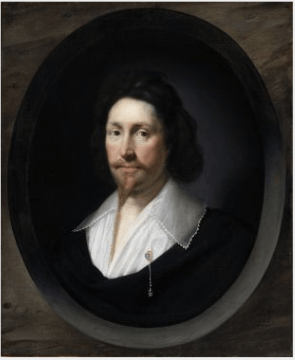John Digby, 1st Earl of Bristol facts for kids
Quick facts for kids
John Digby, 1st Earl of Bristol
|
|
|---|---|
 |
|
John Digby, 1st Earl of Bristol (born February 1580 – died January 21, 1653) was an important English diplomat. He worked for the King and tried to find peaceful solutions during the English Civil War.
Contents
Starting His Career
John Digby was the son of Sir George Digby. He studied at Magdalene College, Cambridge and became a knight in 1606. He was also a Member of Parliament for Hedon for a short time in 1610.
Working for King James I
When John Digby came to the royal court, he quickly became a favorite of King James I. This was because he was charming, good-looking, and very skilled at diplomacy. King James I sent him to Madrid, Spain, as his ambassador in the early 1610s.
For his excellent work, John Digby received special honors. He was made Baron Digby of Sherborne in 1618. Later, in 1622, he became the Earl of Bristol.
The Spanish Marriage Plan
Digby played a big part in a plan called the Spanish Match. This was an attempt to arrange a marriage between Prince Charles (who would later become King Charles I) and the Infanta Maria Anna of Spain, a Spanish princess. However, the marriage plan did not work out.
Digby was blamed for the failure of the marriage. He was called back to England and told to stay on his own land. When Charles became King, he offered Digby a chance to return to royal favor. But Digby had to admit that the failure of the marriage was his fault.
Conflict with King Charles I
John Digby was a very stubborn and hot-tempered man. He refused to admit blame, which made King Charles I very angry. The King then tried to remove Digby from his position through a process called impeachment. Digby was sent to the Tower of London.
But Digby was not afraid. He made his own accusations against George Villiers, 1st Duke of Buckingham, who was the King's closest friend. The House of Lords decided to listen to Digby's side of the story first. His trial never finished, but he stayed in the Tower until 1628. This event made many people question King Charles's fairness.
Returning to Royal Favor
In 1628, the Duke of Buckingham was murdered. This made Digby rethink his strong opposition to the King. Like other important lords, he was worried that Parliament was becoming too extreme. He offered his help to King Charles, and they officially made up.
However, King Charles was slow to trust people who had ever gone against him. So, John Digby did not have much influence at court during the 1630s.
Role in the Civil War
As the political problems grew in the early 1640s, Digby became a trusted and moderate adviser to the King. His son, George, Lord Digby, also advised the King. In September 1640, at a meeting of important lords in York, the King actually listened to Bristol's criticisms. He agreed with Digby's advice that a Parliament needed to be called.
Working for Peace
By 1641, King Charles and Digby were fully reconciled. Bristol, along with Lord Bedford, became a leader of the moderate Royalists in the House of Lords. They worked hard to find a compromise with John Pym, a leader of Parliament. They also tried to save the life of the Earl of Strafford.
When the attempts at compromise failed, Bristol was increasingly seen as a "hardline" royalist. After the Civil War began, Parliament put him in prison. However, he was later allowed to join the King at Oxford.
After the Battle of Edgehill
After the Battle of Edgehill, Digby was part of a group of "moderate" advisers. They convinced the King not to try and take London. Some people believe that taking London might have ended the war quickly. After the King's defeat, John Digby moved to Paris, France. He died there in 1653 at the age of 72.
His Character
Clarendon, who knew and liked Bristol, described him. He said Digby had a serious look and a presence that earned respect. He was also a very handsome man. He became an ambassador to Spain before he was 30, thanks to King James's special favor.
Clarendon noted that Digby was very smart and wise in his advice. However, he could also be very emotional and proud. He tended to talk too much, so he wasn't always respected in discussions. A modern historian called him "the terrible earl" because of his quick temper and strong personality. Despite this, the historian praised him as the greatest servant of the English Crown of his time.
Family Life
Lord Bristol lived at Sherborne Castle in Dorset. In 1609, he married Beatrice Walcott (who died in 1658). She was the widow of Sir John Dyve. John and Beatrice had four children who lived to adulthood:
- George Digby, 2nd Earl of Bristol
- Mary Digby (1612–1648), who married Arthur Chichester, 1st Earl of Donegall. They had six sons and one daughter, but all died as babies. Mary died in 1648 while giving birth.
- John Digby (1618–1664)
- Abigail Digby (died 1640), who married George Freke. They had one son named John.
Through her first marriage, Lady Bristol was also the mother of Sir Lewis Dyve, who was an important Royalist. John Digby was also the uncle of Sir Kenelm Digby, a famous English courtier and natural philosopher.


